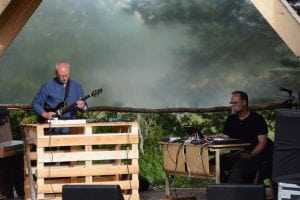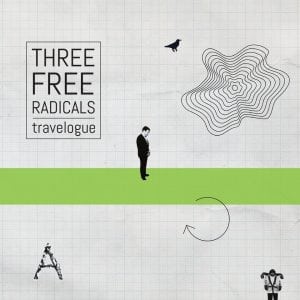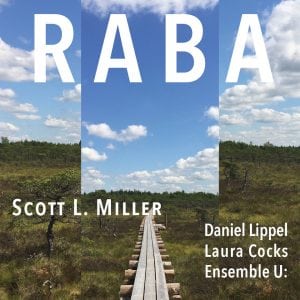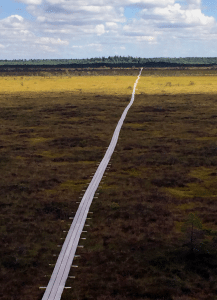I first met Scott Miller at SEAMUS 2013, hosted by McNally Smith College in the Minnesota Twin Cities area, not far from Scott’s home in St. Cloud. I had been corresponding with him via email about the new “Electro-Acoustic Miniatures: Re-Caged” I had helped curate and judge, and enjoyed our virtual interactions, so I was pleased to share a couple meals with him and see him around the conference. When he ran for SEAMUS President I was happy to support him and enjoyed working with him as SEAMUS Newsletter Editor. We’ve both collaborated with pianist Keith Kirchoff, and seem to continue collecting common friends in the electro-acoustic music and composition world. I love Scott’s personality and sense of humor, and appreciate his generous and gregarious nature. I think it has obviously led to many of his collaborative approaches to music, and I think it showed through in how he handled himself as President of SEAMUS. I appreciated sending him the following questions about his recent work and awards and hope you enjoy his thoughtful answers.
SR: Where were you born and what are some of the earliest musical influences you remember?
SM: I was born in Beaufort, SC but grew up in NY. The earliest musical influences that really set me on the path of composing: discovering Koyaanisqatsi during spring break my freshman year, being introduced to King Crimson and prog-rock in general, Charles Mingus’ album Ah-Um, Laurie Anderson’s O Superman, and David Byrne’s The Catherine Wheel.
SR: When and how were you first introduced to electronic music, and why do you think it took hold?
SM: I remember clearly in 6th grade music class being introduced to Hot Butter’s version of “Popcorn” <https://www.youtube.com/watch?v=YK3ZP6frAMc> (you can clearly hear the connection to the music I write ;P). I was intrigued by the Moog modular on the album cover that our teacher showed us. It would be a long time before I had an opportunity to try my hand at one of those myself. I’m not so sure it took hold so much as I always thought of instruments you plug in as equal partners in the world of instruments and the music that resonated with me seemed to agree.
SR: You have THREE times been named a McKnight Composer Fellow—how did those awards come about and what opportunities did they provide for you?
SM: Yes, I was just awarded a 2018 McKnight Composer Fellowship, my third, quite a surprise and a great honor! These are for mid-career Minnesota composers; the first was in 2001 and it enabled me to build a home studio around a Kyma system, which really moved me 100% over to the “electronic music composer” category. The deep dive into Kyma led me to where I am now with creating a lot of music collaboratively, integrating improvisation and real-time computer performance/synthesis/coding into what I do. The first example of this is on my first CD, Shape Shifting, which is a concert length show I created with and for the ensemble Zeitgeist, poet and spoken-word performer Felip Costaglioli, and video artist Ron Gregg.
The second McKnight, in 2013, coincided with my establishing an electro-acoustic improvisational band, Fifth Column, which toured Minnesota performing with different local improvisers in each location—rock and jazz guitarists, the drummer from the Luv’n Spoonful, a DIY electronic instrument maker creating “folk music of the future,” and a band of robots. That McKnight also supported the composition of Every Problem is a Nail (commissioned and recorded by Keith Kirchoff < https://store.cdbaby.com/cd/keithkirchoff4#.W1kb9fLFSCg > < https://youtu.be/DVo-kpcZVAE >), it underwrote the recording of my CD Tipping Point < http://www.newfocusrecordings.com/catalogue/scott-miller-tipping-point/ >, and provided a residency at Montalvo Arts Center, which itself led to so many things I’ve been busy with the past few years.
I’m in the planning stages of how best to make use of the most recent award. Work that I’m pursuing right now includes a new piece for VR and live music, which I am writing for soprano Tracey Engleman and Zeitgeist for premiere in November 2019; it will involve Minnesota-based imagery and the text is the poem, The Blue in the Distance, by Minnesota Poet Laureate Joyce Sutphen. I am just wrapping up a GPS/AR composition that changes the mix of different stem tracks based on the listener’s location on the SCSU campus, the first piece of a new project exploring Sonic Augmented Reality (SonAR). The synthesized sounds are inspired by the dominant sound sources experienced in the summer at various campus locations. The listener downloads an app to their phone, and as they navigate the campus, they hear an evolving and unique mix of the composition, which also interacts with the ambient sonic ecology bleeding through the headphones (of course, noise canceling headphones or damaging audio levels will defeat that element of the composition).
SR: What draws you to VR, and what do you feel is its most interesting creative potential?
SM: My original point of entry was driven by the interest of Ensemble U: to commission VR audio-visual works of iconic Estonian locations. This and the support from the SCSU Visualization Laboratory led to the creation of Raba. During the development of the piece, I was able to explore a variety of applications I’m now pursuing, and each is a different application of VR/AR technology to the creation and experience of music. One thing that is very important to me is that this includes music created or performed in realtime, for instance, synchronizing the experience with human performers, transforming sound based on the physical location of audience members, or generating sound based on the VR headset orientation of the audience members.
If we’re thoughtful about it, I think VR and AR will open up new possibilities for sonic arts that still value human performance, collective experiences, and unique experiences that encourage repeated engagement.
SR: What tools do you use to create/edit sound for use with VR graphics?
SM: I’m working with Kyma, Pro Tools, DSP Quattro, and the assorted hard/software processors that I normally work with. This is because I am not (presently) interested in the kind of immersive audio experiences that seem most frequently associated with VR (e.g. Ambisonic encoding of 360º audio/video recording for playback, or 3D audio in gaming environments). Unity3D is the VR environment I’m working in. So far I prefer the results I get from creating immersive audio for multichannel playback or headphones using the tools I have rather than the 3D audio processing I’ve experimented with in Unity. I think this may be as much about the music I make, as anything else.
SR: You once compared your approach to music composition with sexual fetishism 🙂 …without trying to be too crass, I thought it was a funny and interesting way to describe your focus as a composer—can you talk more about that? Your music, that is…
SM: That sure paints a picture, doesn’t it? I’ll skip directly to the relevant part. Most human beings enjoy music in some capacity or another: listening, performing, creating, or even just as an accompaniment to the day’s activities. A lot of folks agree on certain musical styles, genres, and even specific compositions as that which they enjoy; they maybe are unaware of alternative choices, or reject them for lack of providing enjoyment, and that’s okay. I’ve made peace with the reality that I enjoy making and listening to music that truly appeals to a niche audience with specific tastes or expectations, so my great challenge is remaining true to our collective aesthetic pleasures and figuring out how to connect with the audience for my music. In my experience, it tends not to conform to the expectations of most people.
SR: How did your Fulbright to teach at the Estonian Academy of Music and Theatre come about, and what were the most memorable and important parts of the experience?
SM: I was looking into a Fulbright generally and reading about the different disciplines that various countries were interested in for that round. Whereas most countries simply identified “music” as an area of interest, Estonia stood out for very specifically requesting “electronic music composition,” which, as it so happens, is I was both qualified and looking to do! I really enjoyed my time in Tallinn and largely because of the vibrant, active, and welcoming new music community. For example, the Estonian Academy of Music supported me bringing in performer-collaborators (Pat O’Keefe, Nathan Hanson, and Anne Laberge) for a four concert series of my music while I was there. I was surprised to find an incredible experimental/improvisational scene in Tallinn, which I was able to engage with early in my stay. I was able to really exploit the ecosystemic improvisational programming I had been creating leading up to my residency there. One of the most memorable experiences was an improv concert with saxophonist Michel Doneda and electronic musician Taavi Kerikmäe at midnight in Niguliste, a medieval church which features an astonishingly long echo and active sonic environment. We installed speakers throughout the sanctuary, adjacent rooms, and choir lofts and an ecosystemic method of spatializing Kerikmäe’s electronic sound. Doneda’s 60-minute improvisation was performed while navigating the perimeter of the sanctuary. What and where Doneda performed determined where Kerikmäe’s sound would move to, or come from, itself influencing the spatialization in a tremendous, almost self-sustaining sonic ecosystem.
In addition to my work with pianist/improviser Taavi Kerikmäe, some other musically productive and lasting relationships I made were with the new music group Ensemble U: and guitarist/composer/improviser Mart Soo. Mart and I created a free improv duo, Three Free Radicals, which now has released two albums (Diary of a Left-Handed Sleepwalker and Travelogue) and we have a third in the can, which we recorded with harpist Liis Viira last August. We’ve performed on the Improtest series and Kukemuru Ambient Festival, and I would love to do a tour in the U.S.
My experience in Tallinn inspired me to establish a series of electroacoustic free improv concerts after returning home. I paired up with Ted Moore, an active composer and improviser in the area, who is now located in Chicago. Together, Ted and I presented 15 concerts over two seasons in Minneapolis and St. Paul as Ars Electroacoustica. The structure behind the series was the same as with Fifth Column, that each concert feature a different guest improviser, in order to attract audiences from each of our respective fan bases. We performed with guests from the Twin Cities and nationally.
SR: In the artist statement on your website you lead out with the following sentence: “My music is characterized by collaborative approaches to composition, the use of electronics, and improvisation.” How is this manifest in your recent Three Free Radicals release? And in other recent (or not-so-recent) works?
SM: Three Free Radicals is a true non-stop collaborative-composition/free improv relationship between Mart Soo and myself. Being separated by 8 time zones, each album and performance documents an unscripted meeting following a single rehearsal or soundcheck. My approach involves creating three or four collections of patches (Sounds) in Kyma, contained in a Multigrid which allows me to perform any or all of the patches at any moment. Some of the patches are ecosystemic, some process Mart’s guitar/electronic sounds, some are synthesizers, and some sequencers. Given an idea of what might result from different kinds of input, my approach to improvising involves constructing a sonic world that Mart can enter into musically and transform with his own sound or find a coexistence within. The results are often less about formal structure and more about process. I’m especially interested in creating music that is texturally interesting, polyphonic, and dense with sonic information. Answering your question makes me realize that Mart and I have never really spoken about this, and maybe we shouldn’t; we’ve just let the musical interaction unfold. Sometimes, in the studio, we will do a second take of what we just recorded, usually when there’s a particularly interesting idea that emerges but that would benefit from knowing in advance we are going to do it. Other times, we explore a good idea but for entirely too long, and so a second, focused take provides what we’re looking for in a structure that isn’t indulgent or just long-winded.

SR: Tell me more about your piece Raba—I know it represents years of development, research, and some perhaps unexpected intersections…
SM: I wrote Raba in 2015, inspired by a visit to a bog in Estonia (raba means “bog” in Estonian). This piece ultimately became the basis for a new collaboration and a new direction in format for my work: concert pieces for virtual reality/immersive media systems. In 2017 Ensemble U:, Maru VR, Mark Gill of the St. Cloud State University Visualization Lab, and I created, recorded, and produced the virtual reality concert version of Raba. <https://youtu.be/kL2IJpIekqw> It is experienced by an audience seated in swiveling chairs, wearing VR headsets. Audience members visually explore a 360º film of the Marimetsa Raba while Ensemble U: performs the music in sync with the film, located around the audience, creating an acoustic surround sound. What excites me about this is that the audience is immersed in the collective sonic reality of the space, while virtually immersed in the visual beauty of the Marimetsa Raba. There is tremendous creative potential for this format, and I think it is especially well suited for connecting with new audiences for my music. It has been well received and is programmed at the VRHAM Festival and the Baltoscandal Festival this summer.
Raba functions as a kind of touchstone for the trajectory of my creative life. Many of my compositions can be described as environmental sound art. This isn’t to say they are activist oriented, overtly political, or reminiscent of recognizable territory, but more frequently they are ecosystemic in design. Ecosystemic music models the behavior of objects from the natural world in electronic sound. This modeling creates interactive ecosystems of sound, and a finished product that may include human performers, take place in a concert hall, or on a hilltop. This is an approach to programming/creating electroacoustic music I was introduced to by Agostino DiScipio in 2004 at CCMIX.
Working with ecosystemic programming has transformed the way I listen to sound in a space, and led me to an interest in activating performance spaces with sound in different ways. Increasingly, I am composing music that I describe as more patient. I am employing musical gestures that operate nearer the threshold of sound, and exploring how to transform sonic ecosystems with the addition of elemental musical materials that support, complement, or excite the ambient environment. While not all of my work is ecosystemic, the thinking behind it informs more and more of what I do.
My recent work has followed two paths, which sometimes intertwine. The first path, which I discussed a little bit above, is actively performing and recording with a wide variety of improvising artists. These activities frequently operate as a kind of proving ground for programming and synthesis that finds its way into my through-composed works. Frequently these involve ecosystemic programming, and presentations in a broad variety of venues and settings. The second path is that I’ve renewed and developed new collaborative relationships with film and video artists. Of great interest to me is developing work for virtual reality and augmented reality, such as in Raba. I think VR and AR will become major platforms for experiencing new music in the near future. VR offers me the opportunity to extend my ecosystemic principles into a virtual space, where I can define the relationship between audience and sonic ecosystem in wholly new and unexplored ways.
And so the piece, Raba, became the title track of my latest CD, Raba, which is a collection of audio visual works dating back as far as 20 years, which all have a connection to the environment whether as sound source, compositional conception, or ecosystemic programming. The videos are available on YouTube and limited edition DVD, and I must say that the liner notes, written by Brett Wartchow, are pure poetry. The album represents a point of compositional arrival, and I think also a point of departure. I have more to explore in this vein.
SR: How would you sum up your time as SEAMUS President, in 30 words or less. 🙂 Just kidding. But seriously, what were some of your goals and expectations coming in, and how have those played out?
SM: My attitude has always been that SEAMUS is a membership organization, and that our purpose should be to provide services and opportunities to our members that they value. One goal I had coming into the presidency was to respond to the needs of our Performer members. I’d been contacted as Vice President of Programs by several Performer members who wanted to talk about what we could do to directly meet their interests. As President, I was able to work with Keith Kirchoff (my successor as VP of Programs) to implement the Performer Curated Concert, which has now been a part of two National Conferences. Keith took the lead on this and his perseverance made it happen; we learned exactly how difficult it can be to implement something as seemingly simple as a 45’ concert. But it was absolutely worth it, since we’d had a “Performer” member category for years but those members weren’t necessarily feeling included in the opportunities we provided. A tangential program that came from this (at Keith Kirchoff’s initiative) is the SEAMUS recording series “Interactions,” for electro-acoustic music with a live performance component. I see in this exactly what we can do as an organization, which is listen to the membership and try our best to respond to their needs.
Listening to the membership led to the adoption of the SEAMUS Statement of Nondiscrimination <https://seamusonline.org/statement-of-nondiscrimination/> and establishment of a new board position, that of Diversity Officer. Again, I was contacted by some members about our policies regarding inclusivity, particularly where adjudication and programming were concerned for conferences. So I contacted SCSU’s Office for Institutional Equity and Access to ask what our organization could do, positively, in this regard. Their recommendations included adopting a nondiscrimination statement, creating an appointed board position to provide leadership in this endeavor, begin data collection about our membership, and ultimately revisiting the organization Mission Statement. Generally, their advice was to encourage change from the ground up, directly from members. The board adopted our Statement of Nondiscrimination, and have very seriously implemented policies regarding adjudication that are designed to include as broad a representation of our membership as possible. I appointed Elizabeth Hinkle-Turner to serve as our first Diversity Officer in 2017, and under her guidance, we are beginning to collect and analyze data about who our members are, which is a step in the direction of figuring out who we wish were participating and how to make them feel welcome. This is where identifying the services our members value can come into play. For many, having music programmed on the National Conference and attending it is the most valuable thing we offer. But for others in the electro-acoustic music community, it may be something else that we don’t yet do but easily could, that would make being an active member of the organization important.
Finally, I am really pleased to have overseen the establishment of SEAMUS Records as an imprint of New Focus Recordings with worldwide distribution via Naxos. One of the important outcomes of this is our project re-releasing the first 25 years of Music from SEAMUS (the “Scott Wyatt Era” :)), which has been receiving international attention from reviewers and broadcasters. I am honored to have served as interim Director of Recordings the past year and to have been asked to stay on in this role by our new President, Ted Coffey. I hope we can continue to expand the opportunities and distribution of member music in the coming years.
SR: How has SEAMUS changed in your time as President–in both ways you wanted and perhaps facilitated, or just in unexpected ways?
SM: I think the greatest change has occurred in terms of our digital presence and how members and the world can interact with us on the web. The website was radically redesigned 4 years ago and along with it, we transformed the submission technology and process, much of which has been shouldered by Adam Vidiksis. Along with this is our transformation of the adjudication process in general, which I mentioned above. This was led very much by Eli Fieldsteel, with a lot of valuable input from Jeff Stolet, Adam Vidiksis, and Tae Hong Park over the past two years. These are all really important changes and I think SEAMUS is much stronger for them.
SR: What are your future wishes for SEAMUS and its members?
SM: More than anything, I want SEAMUS to continue to grow and develop as an organization that provides a variety of meaningful and unique services to a broad membership. I’m thinking of different kinds of music dissemination, including recordings, broadcasts, and performances, different kinds of networking we can facilitate, sharing opportunities, connecting musicians and presenters—I imagine there are a lot things we can do to make being a member of SEAMUS even more valuable. I’m also certain that we, as an organization, can do a lot to develop audiences for and increase participation in the music that we make, again, by harnessing the resources and stature of a national organization to offer services and coordinate activities to this end.



